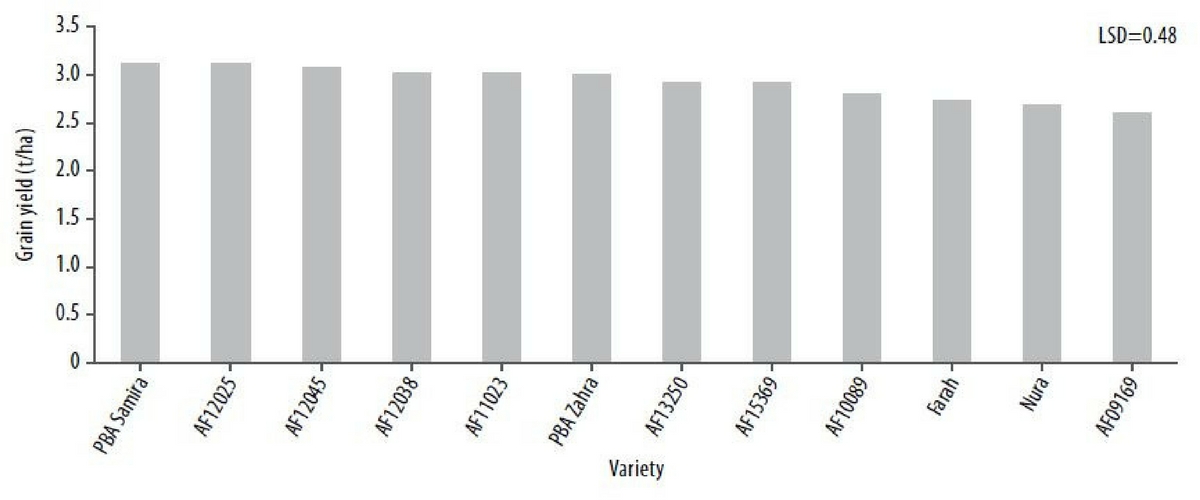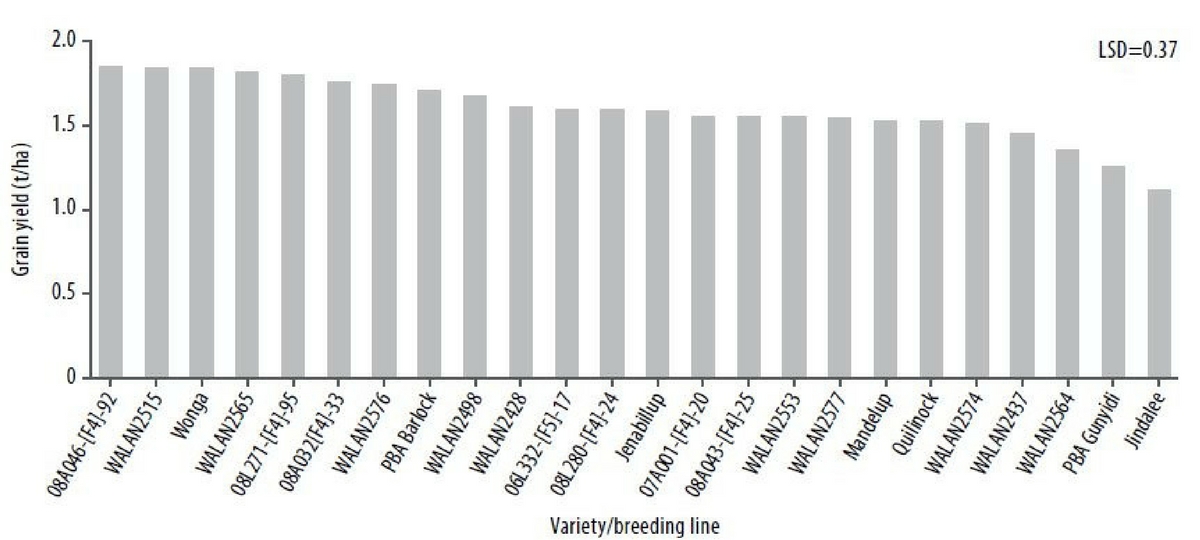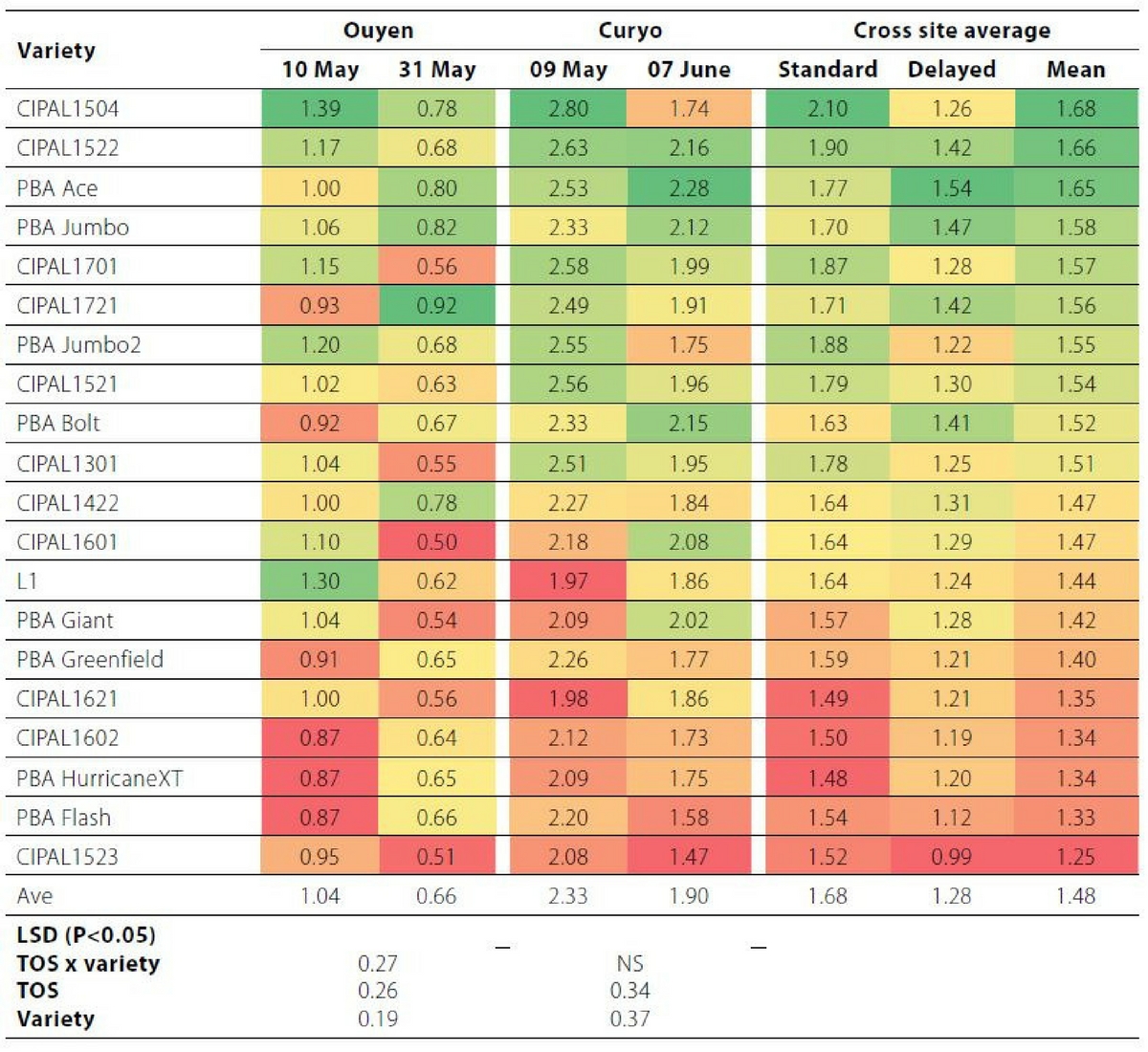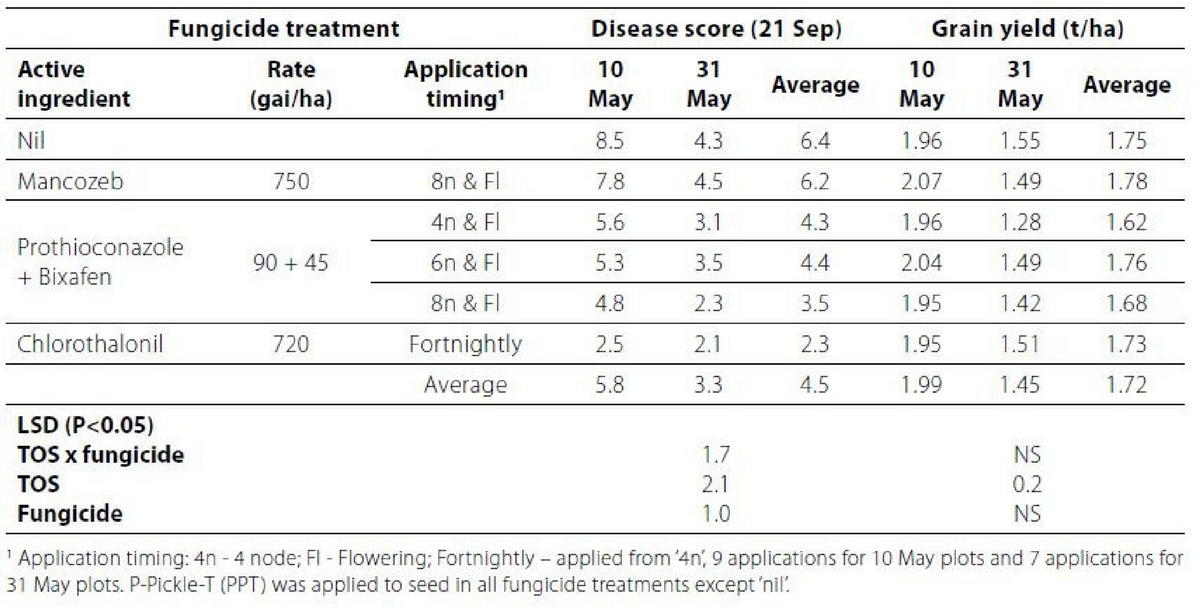Take home messages
- For some regions, 2017 could be termed a ‘reality check’, after the excellent yields, prices and profitability observed in 2016. For example, in some lower rainfall zone areas, lentil yields were lower than 0.5t/ha combined with prices less than $500/ha. Despite the lower returns from pulses in some areas, we continue to see their value in the whole cropping system with higher yields in cereals observed following the pulse phase.
- Delayed sowing in field trials generally resulted in significant yield losses in pulses across all
Victorian sites, with losses ranging from $200–$250/ha in lentils and $100–$600/ha in chickpeas. Significant varietal variation in response to sowing date was observed with losses greater than 50% from delayed sowing observed at Curyo in lentils. - When choosing new varieties or changing agronomic treatments it is important to look at longterm information rather than individual seasons. Varieties like PBA Jumbo2 lentils have performed well across a range of seasons, indicating yield stability.
Background
The Southern Pulse Agronomy (SPA) program conducts a wide range of agronomic and variety pulse trials across all rainfall zones of Victoria and South Australia. Its primary aim is to improve yield and yield stability, ultimately leading to increased profitability and adoption of new varieties by growers. In this report, key results from selected trials conducted in the southern (Curyo) and central (Ouyen) Mallee 2017 are highlighted. Further details relating to trial methodology and other measurements recorded will be available in a detailed report by May 2018.
Sowing dates
A range of higher yielding pulse varieties have been released, with improvements in agronomic traits including biomass production, lodging resistance, disease resistance, herbicide tolerance, maturity and pod retention. In addition, growers are sowing crops earlier to maximise yield potential and reduce risks of heat and terminal drought stress. However, this can also increase risk of disease and frost or poor pod set under cold conditions. Research in 2017, focused on understanding the variability in lentil, chickpea and field pea varieties and breeding lines in response to sowing dates.
Herbicide tolerance
SPA has been evaluating an elite PBA faba bean breeding line incorporating Group B tolerance traits (developed through a SARDI germplasm enhancement program), in parallel to Group B tolerant lentil variety PBA HurricaneXT, in a range of agronomic trials over the last few years with promising results. The germplasm enhancement program has also explored a range of other herbicide traits in lentil, including Group C tolerance, and has more recently started trait development work in chickpea and field pea. However, extensive characterisation, genetic understanding, and evaluation of the commercial potential of all these traits are still required to deliver all of these traits to market. A trial at Ouyen in 2017 investigated the response of the new Group B tolerant faba bean breeding line to a range of Group B herbicides on lighter sandy soil in a low rainfall zone environment.
Disease management
In field pea, blackspot continues to be a major limitation to production. Research by SPA in SA and Vic suggest there are opportunities to minimise the risk of blackspot by combining novel fungicide applications, with improvements in genetic resistance enhanced by plant morphological and architectural differences. In chickpea, resistance to ascochyta blight has recently broken down and implications for management packages need to be elucidated. In 2017 trials at Ouyen focussed on novel disease management strategies in field peas, while at Curyo fungicide strategies to manage ascochyta blight and minimise yield loss in chickpeas was investigated.
Faba beans and lupin germplasm
In the faba bean breeding program, several lines with significant yield improvements in dry areas have been identified. At Curyo in the dry season of 2015 and wet season of 2016 the line AF12025 yielded 158% and 140% of PBA Samira, respectively. Improved moisture conservation techniques mean that, beans may be considered within the farming system, particularly as they are one of the best nitrogen fixing pulses. In 2017 similar to 2015 and 2016, a number of new breeding lines were tested to maximise yields at both Curyo and Ouyen.
A number of lupin breeding lines from trials in 2015 were selected with potential adaptive traits for south eastern Australia. In 2017, at the central Mallee site (Ouyen) a range of breeding lines were assessed similar to 2016 to identify those more suitable for the modern farming systems used in Mallee regions.
Aim
To improve yield and yield stability of pulse crops, ultimately leading to increased profitability
and adoption of new varieties by growers.
Paddock details
| Location: | Curyo and Ouyen | |
| Crop year rainfall: | Curyo – 297mm, Ouyen – 312mm | |
| GSR (Apr-Oct): | Curyo – 243mm, Ouyen – 199mm | |
| Soil type: | Curyo – Sandy loam, Ouyen – Loamy sand | |
| Crop types: | See Table 1 | |
| Sowing dates: | Curyo – 9 May and 7 June; Ouyen – 10 and 31 May | |
| Sowing system: | Inter-row with narrow points and press wheels in a no-till system (row spacing: Ouyen – 30cm; Curyo – 36.5cm). | |
| Harvest dates: | Curyo | 9 and 13 November – lentils and peas 28 and 29 November – faba beans and chickpeas |
| Ouyen | 3-5 November – peas, lentils, faba bean germplasm and lupins 16 November – chickpeas and faba bean herbicide tolerance |
|
Table 1. Overview of agronomic trials (cells marked ) at Curyo and Ouyen in 2017.
Climate
Curyo
Table 2. Temperatures and rainfall at Curyo 2017.
Ouyen
Table 3. Temperatures and rainfall at Ouyen 2017.
Results and interpretation
Sowing dates
At the Mallee trial sites for all crops assessed there was a reduction in yield from delayed sowing ranging from 9 to 37% (Table 4). For chickpeas at Curyo, this equated to an average reduction in gross margin of more than $500/ha (up to $900 for some kabuli’s). The magnitude of response was related to a number of environmental factors including moisture at sowing, and timing of frost and heat events. Due to the relatively dry spring conditions and active management, disease was not an issue in all trials.
Soil moisture was generally optimal at the earlier ‘standard’ sowing date and dryer at the delayed sowing. This combined with the warmer air and soil temperatures, meant that the establishment and early growth of the earlier sown treatments was much more vigorous and advanced than the delayed treatments. For much of the season the earlier sown plots were approximately 4-6 nodes ahead of the delayed sown plots for all crops.
No major frosts impacted the trials at Ouyen and Curyo, but heat and drying conditions during spring significantly impacted the delayed sown treatments, generally resulting in substantially lower yields. However, for chickpeas there was only a 9% reduction in yield from delayed sowing at Ouyen, in contrast to a 28% reduction at Curyo (Table 4). The relatively low reduction observed at Ouyen is likely related to the poor ability of chickpeas to set pods at low temperatures (below 15OC mean daily average). The treatments sown earliest were flowering during colder temperatures, therefore pod set was poor. As temperatures increased, soil moisture become limiting, so both the standard and delayed sowing date treatments set pods during the same period.
Further work is ongoing within PBA looking for traits enabling chickpeas to set pods at cooler
temperatures. In 2017, many of these lines flowered much earlier than current varieties and breeding lines in the trials, but did not appear to set pods any earlier (data not shown).
Table 4. Mean grain yield of pulse crops (across all varieties) sown at standard sowing
dates in comparison with delayed sowing at Victorian Southern Pulse Agronomy trials
sites in 2017.
There was also significant variation in the response of varieties to sowing dates across the various trial sites. Results in Table 5 highlight the trends for lentils in 2017, although similar observations were seen in other crops investigated (data not shown).
Grain yields for lentils were less than 2016, but still profitable, ranging between 0.50 – 1.39t/ha at Ouyen and 1.47 – 2.80t/ha at Curyo. Overall, PBA Ace was the highest yielding commercial cultivar, reflective of its vigorous growth in 2017, equivalent to the highest yielding lines. PBA Jumbo2 was also again high yielding, demonstrating its yield stability across a range of regions and seasons.
PBA Flash was the lowest yielding commercial cultivar and PBA HurricaneXT performed relatively poorly, reflective of industry observations in 2017. It was noted in industry that throughout many regions PBA HurricaneXT appeared to show more visual symptoms from Group C herbicide in early growth and then from frost damage during vegetative growth (pale and burnt upper leaves). Both of these factors could have contributed to the relative lower yields observed in industry during 2017. However, it is important to note that long-term trial yields have always indicated approximately 10% lower yield of PBA HurricaneXT relative to the latest conventional varieties, such as PBA Jumbo2.
Average yield loss from delayed sowing was 37% at Ouyen and 18% at Curyo, however within each site losses varied significantly across variety (1-55% at Ouyen and 3-38% at Curyo; Table 5). There didn’t appear to be a clear link with phenology (flowering and maturity). For example, both CIPAL1504 (mid/late) and CIPAL1523 (early) showing yield losses of 40 and 35%, respectively averaged across sites. Also while some varieties/breeding lines showed relatively consistent yield loss across sites (eg. PBA
Ace and CIPAL1422), others varied greatly (eg. CIPAL1601 and CIPAL 1621). Potential reasons for these responses and implications for breeding and agronomy are currently being investigated.
Table 5. Grain yield of lentil varieties and breeding lines sown at standard sowing dates in comparison with delayed sowing at Victorian Mallee Southern Pulse Agronomy trials sites in 2017. (Varieties and breeding lines ranked based on mean average yield across all Mallee sites; Colours relate to relative yield within a sowing date at one site, green = higher yields, red = lower yields).
Herbicide tolerance
In this trial early growth and vigour was good, but drought stress started to appear in mid July. Due to the ongoing dry conditions and then heat late in the season, grain yields for beans were poor. Similar to previous herbicide tolerance trials, the new Group B tolerant faba bean breeding line showed almost no symptoms of crop damage, and biomass at flowering was slightly reduced, but there was no difference in grain yield (Table 6). These results confirm good tolerance across a range of soil types and rainfall zones. In comparison and consistent with previous results, PBA Samira was almost completely killed by the same herbicide, with severe crop damage and almost no biomass and grain yield produced.
Table 6. Herbicide damage score (0 – no damage, 100 – complete plant death; 17 Aug),
biomass at flowering (23 Aug) and grain yield of the herbicide tolerant faba bean breeding line in comparison with PBA Samira in response to the application of a Group B herbicide at the 4 node growth stage at Ouyen in 2017.
Disease management
Due to the relatively dry spring, disease pressure was relatively low in 2017 across all trials, despite trials being inoculated with infected stubble.
In the field pea trial at Ouyen there was some early infection of black spot that was significantly worse in the earlier sown plots (10 May) compared with the later sown plots (31 May). Among the fungicide treatments, the fortnightly application of chlorothalonil showed the lowest disease scores (Table 7). Plots with ‘Prothioconazole + Bixafen’ showed slightly higher levels of disease compared with chlorothalonil, but significantly lower disease than mancozeb and Nil treatments. Timing of application appeared to have minimal impact on disease levels. Mancozeb showed no improvement compared with the ‘Nil’.
Despite reducing the level of disease, no fungicide treatment resulted in a significant yield improvement relative to the control. This could be expected as spring was relatively dry and disease symptoms failed to progress.
Table 7. Black spot score and grain yield of field pea sown 10 May and 31 May with different fungicide management treatments at Ouyen in 2017. Disease score – number of nodes from base of plant with infection. Trial was inoculated with infected stubble at early establishment.
A chickpea disease management trial was sown at Curyo in 2017, but unlike previous seasons disease pressure was low and highly variable and did not result in any significant yield loss (data not shown). A new fungicide (‘Prothioconazole + Bixafen’) was investigated showing potential improvements in disease control for strategic management programs compared with chlorothalonil (data not shown). Further details will be discussed in the presentation.
Faba bean and lupin breeding lines
The performance of several new faba bean lines identified for improvements in drought resistance was again excellent at Curyo in 2017, with yields ranging from 2.6 to 3.1t/ha (Figure 1). However in contrast to previous seasons, where AF12025 had yields >140% of PBA Samira, in 2017 yields were equivalent (3.1t/ha). A similar trial was sown at Ouyen, with yields ranging between 0 and 0.3t/ha.

At Ouyen, grain yields of the early generation lupin breeding lines generally ranged between 1.4 and 1.9t/ha (Figure 2). Wonga was the highest yielding commercial variety, similar to the highest yielding breeding lines .

Commercial practice
Sowing time
In 2018, growers are encouraged to continue sowing pulses in the optimal sowing window, and avoid delayed sowing unless there is a strategic management advantage related to disease or weed control, or they are being sown in a frost prone region. Long- term, from a Victorian perspective, early sowing has generally proved profitable as heat events and rapidly drying soil during late spring in the flowering and podding phase occur almost every year and cause significant yield loss with delayed sowing.
New breeding lines combining consistently high yields, herbicide tolerance, good biomass, disease resistance and earlier maturity will be available in the next few years.
Results from the trial site at Ouyen indicate significant opportunities to improve the adaptation to the sandier Mallee soil types. Further work will occur to understand the response of lentils across the tops of sand hills and the heavier flats. It is important to always choose the better soil types to minimise crop failure in lentils, particularly avoiding sub-soil constraints.
As indicated in 2016, lentils can be a highly profitable crop and are proving to be increasingly reliable in the Mallee as we improve varieties and agronomy and while prices are good. However, the reduced yields and prices observed in 2017 are a reminder of the volatility that can occur in lentil production. Growers are encouraged to continue to take a long-term view being aware that the long-term price average for lentils is between $500 and $600/t.
Herbicide tolerance
The improved tolerance in new adapted faba bean line to Group B herbicides could allow alternative in-crop weed control options to be developed for faba beans. The tolerance to residual activity to sulfonylureas, is also likely to reduce the residue implications from using this chemistry in the cereal phases of rotations, further enhancing the weed control options across the whole farming system.
Disease management
Fungicide application may prove beneficial to help minimise black spot in field peas in the Mallee, but it may not always be profitable. Further work is required to continue to refine application timing and products to ensure profitability across a range of season.
While no yield losses were seen in 2017 from ascochyta blight in chickpeas, grain yield loss from the new isolate in the most susceptible varieties and breeding lines can be up to 100%. However, the moderate level of resistance in a number of kabuli’s including Genesis 090, means that the disease can still be proactively managed with fungicides to ensure profitable grain yields are produced.
Growers continue to be encouraged to closely monitor all chickpea crops in 2018 and use an
early preventative fungicide strategy to minimise risks of disease, and prevent ongoing reinfection throughout the season.
Faba bean and lupin germplasm
New faba bean lines will offer opportunities for growers in the Mallee, with profitable yields, potentially significantly higher than commercial varieties.
Several new breeding lines appear to have good yields, but only marginally higher than commercial varieties. Further work from breeding companies needs to occur to develop improved plant types and resulting yields for the Victorian and South Australian Mallee.
Acknowledgements
This research was funded by GRDC, AgVic and SARDI (DAV00150). Thanks to the technical staff, Jason Ellifson, and Moodie Agronomy (at Ouyen) for maintaining trials and collecting data.
Thanks to our grower collaborators at Curyo and Ouyen for the use of land.







